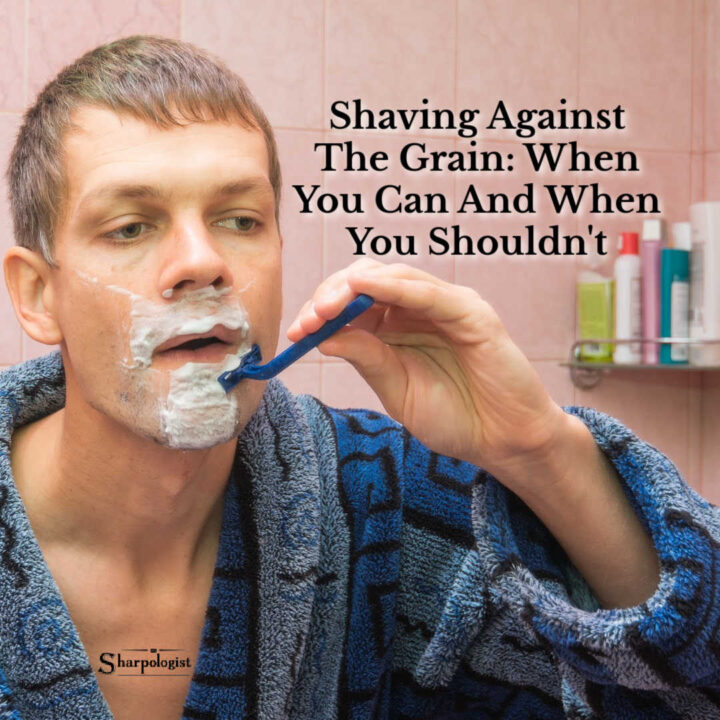
How to get a close shave? Shaving against the grain can provide the smoothest, longest-lasting shave. But in some cases it may not be practical–or desirable. Let’s look at the pros and cons of shaving against the grain, how to do it correctly, and when it isn’t recommended.
What Is Shaving Against The Grain?
Shaving “against the grain” means shaving in the opposite direction of the hair stubble’s growth. As hair grows out it also grows at a certain bearing relative to the surface of the skin. And that bearing is not necessarily consistent, depending on where you are shaving.
How To Determine The Grain? Hair Growth
To find the grain directions of your own beard, wait 12-24 hours after you’ve shaved, then lightly rub the area of what you are shaving from different directions with the tip of a finger. At each point, the direction that’s “smoothest” is the grain at that point.
For the face it is often advantageous to map the grain on a piece of paper. Something like this, for example:
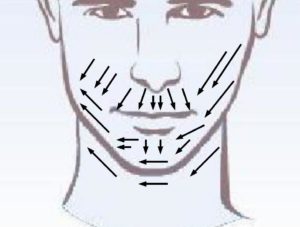
What Are The Advantages Of Shaving Against The Grain?
Shaving against the grain can get a clean shave that’s much closer to the skin. For those looking for the closest, longest-lasting shave the extra bit of time, care and precision is thought to be completely worth it.
While it takes more care to shave against the grain, it can be safe and less problematic if done properly.
What Are The Disadvantages Of Shaving Against The Grain?
Shaving against the grain is thought by some as a “specialist choice” and comes with more risk. Shaving against the grain can cause irritation and razor burn, and can lead to ingrown hairs and razor bumps.
Think twice about shaving against the grain if you are a man-of-color, have very curly hair, are predisposed to ingrown hairs, or have sensitive skin. You don’t want to end up like this:
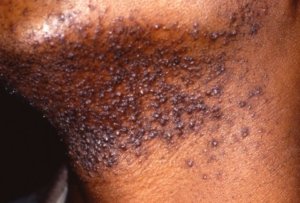
I have a couple suggestions for alternatives to shaving against the grain later in this article.
By the way, shaving against the grain will not make the hair grow back thicker or faster. Click/tap here to read The Ridiculous”Shaving Causes Hair To Grow Back Faster/Thicker/Darker” Myth Debunked By Science! for all the details.
How To Shave Against The Grain
Successfully shaving against the grain takes some extra effort. Shaving against the grain without thinking about a number of variables is much more likely to result in poor outcomes. Here are some things to consider even before the shave:
Prep (And The Importance Of Water)
Though, careful preparation is essential to shaving against the grain. The area to be shaved must be properly cleaned and hydrated before shaving. That means cleaning the skin with a cleanser made specifically for the face (even if you’re shaving something else. “Body bars” or “deodorant bars” can strip off too much of the skin’s natural oils needed to aid with shaving) and using lots of (preferably warm) water.
Related Post: Do Skin Pores Really Open And Close? The Science
Razor, Blade, Cartridge
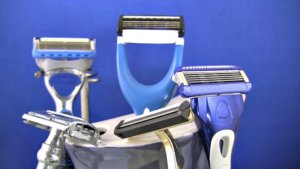
The selection of razor can be important to shaving against the grain too. In this case a cartridge razor with multiple blades and “lift and cut” technology can actually be more problematic as it is more likely to cause irritation or razor bumps.
Consider using a cartridge razor with fewer blades, spaced farther apart, such as the Gillette SkinGuard. Or better yet use a safety razor with a single blade! There is a wide variety of choices, from the classic double edge safety razor to safety razors with a pivot like cartridge razors but with only one blade.
Using a razor with a single blade also may give you the ability to shave in the predominant direction related to the grain, instead of having to slavishly take every twist and turn.
And it should go without saying that you should not use a razor blade/cartridge that is passed its prime: a sharper blade edge will yield better results.
Lather
The shave product you choose for shaving against the grain should be a really good one. A canned shave foam from the discount store is not going to cut it here (if you will pardon the pun). The shave product should be both highly lubricating and highly protecting. Take a look at Sharpologist’s best shave soap and best shave cream lists for some easy recommendations.
How To Get A Close Shave: Process, Direction, And Technique
When it comes to the actual shave, shaving against the grain is not just “shaving against the grain.” Shaving against the grain is a careful, patient, multi-step process.
In general use short, gentle strokes to avoid applying too much pressure on the razor’s blade edge(s). Shaving relatively slowly is a key concept as well. Keep the wrist locked onto the razor’s handle and move the razor with the arm as a unit to help maintain a consistent shave.
But the biggest general concept to keep in mind for shaving against the grain is that the shave should be accomplished in stages (or passes) with each pass progressively reducing the stubble: the actual against-grain shave strokes are accomplished late in the shave process.
Step 1: shave with the grain.

After preparing and lathering the first pass is with the grain. If the arrow above is a skin segment’s “grain” the shave follows the same direction. The direction of shave stroke may change as you move from one segment to the next, but still follows whatever that direction is.
The purpose here is to start reducing the bulk of the stubble in the most comfortable way. The “closeness” of a shave is not a factor here: it’s an almost casual process.
Step 2: After completing the first pass, rinse the area briefly, re-lather, then shave across the grain.
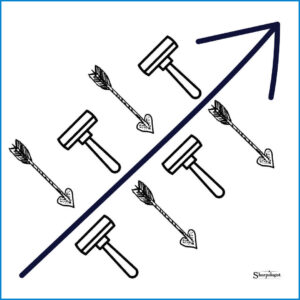
Here you are further reducing the stubble, and getting a progressively closer shave, by shaving with strokes perpendicular to the grain.
Step 3: After completing the second pass, rinse the area briefly, re-lather, and shave against the grain.
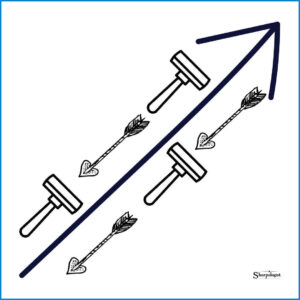
Here you are finally getting your closest-possible shave. The stubble has been previously reduced enough to significantly reduce the chance of irritation or ingrown hairs in most people.
If at any time during this process the shave feels uncomfortable or draws blood…STOP. Do not continue with the pass. Finish up as best you can, if you can (perhaps trying one of the alternatives below), then proceed with your post-shave routine.
Alternatives To Shaving Against The Grain
How to get a close shave if you find you cannot shave against the grain? There are a couple of alternatives to try that may get a closer shave:
Two Cross-Grain Passes
Instead of the against-grain pass, repeat pass two above but from the opposite direction.
This understated approach to shave direction has several benefits. It can not only prevents ingrown hairs and breakouts, but also can further reduce stubble for a closer shave.
“Crosshashing”
Another alternative to the against-grain pass is a “crosshash” pass at a direction near the against-grain direction–say, 45% off:
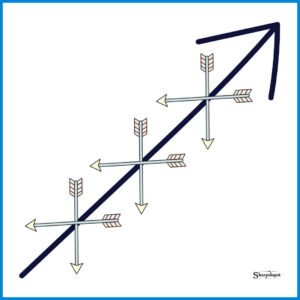
You can experiment to find the best direction for the closest shave without irritation.
After Shave Skin Care
After shave skin care can often head off some of the problems shavers can experience with shaving against the grain:
- After shaving, rinse thoroughly with warm water to wash away any lather residue that might be left behind from shaving. An additional cleansing step I like to do is to soak a cotton round with a no-or-low alcohol witch hazel or toner product and wipe down the shaved area.
- Rinse again with cool water.
- Apply an aftershave splash or balm with a lighter consistency (vs. a “heavy” balm) to reduce the possibility of clogged pores or ingrown hairs but still provide some protection and calming properties for redness or irritation.
Dealing With Skin Irritation Shaving Against The Grain
If you do run into problems, there are a number of products and strategies to deal with shave bumps and ingrown hairs:
- A hot compress
- Physical exfoliation with a specialty brush
- Over-the-counter Salicylic (or Acetylsalicylic) Acid or specialty aftershave products
Click/tap here to read 6 Ways To Treat Razor Bumps After You Already Have Them for a thorough discussion!
Conclusion
Shaving against the grain can result in a close, long-lasting shave for many shavers, if done properly. However it is not recommended for those predisposed to certain hair or skin conditions.
What is your experience with shaving against the grain? Any other tips? Leave a comment below!

I do everything “wrong”. I use nivea canned foam and a leafe thorn razor. I wash my face under the shower and go directly against the grain. My skin gets a little bit dry and I have to change blades fairly often but thats it…
Defnitly want to try brushless shaving cream.
Thanks for the informative article Mark.
To achieve a bbs shave I set my Rockwell 6s razor on 6 and shave with the grain on first pass then across the grain on second pass, great result, no bumps or burn plus shorter shave time, I have a sensitive fair skin and medium density wiskers
Another excellent article!
I have been shaving against the grain with a safety razor for 11 years… And what I’ve learned is essential is the NO PRESSURE tip. Plus all the trimmings (pun intended…) of course… hydration, good lather, right angle, patience, practice, practice, practice…
I always shave with the grain (after which I get a SAS), then across the grain, and then against the grain… for that smoothest baby bum result.
Keep up the good work!
When I first started shaving with safety razor, I figured out that could get a closer shave by shaving against the grain of my face. The very first time I got through using a safety razor, which was a Merkur 25c, I felt face and discovered I my face still wasn’t BBS like I wanted it to be and shaved my entire face again going against the grain this time. It worked like charm, to my delight.
Comments are closed.